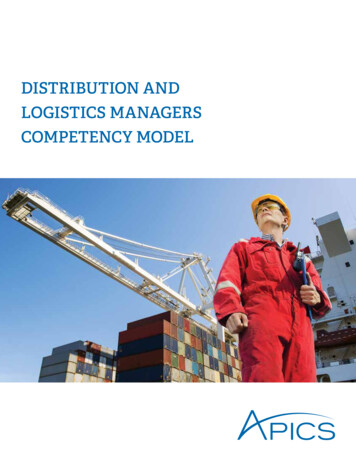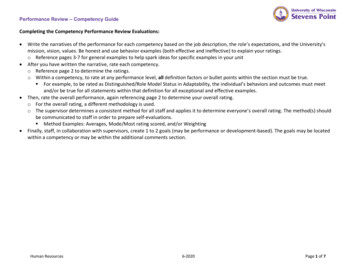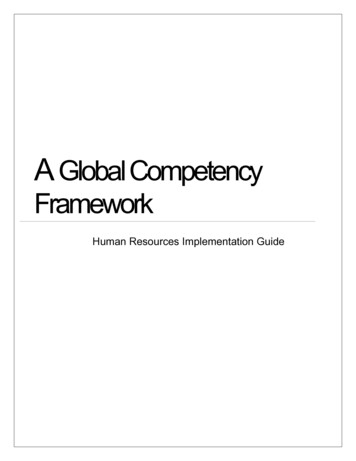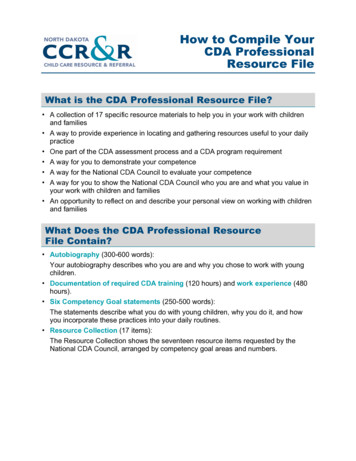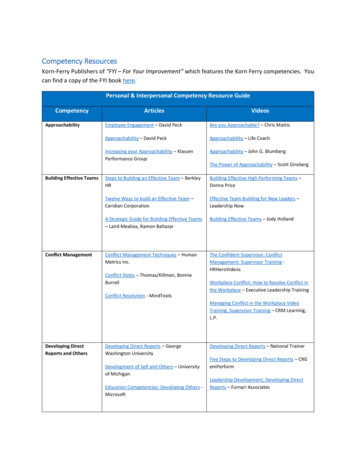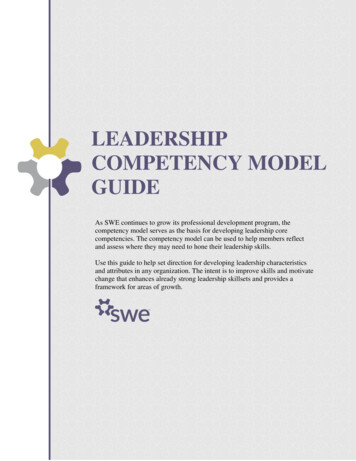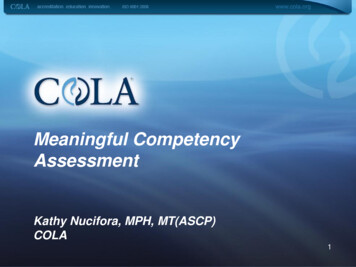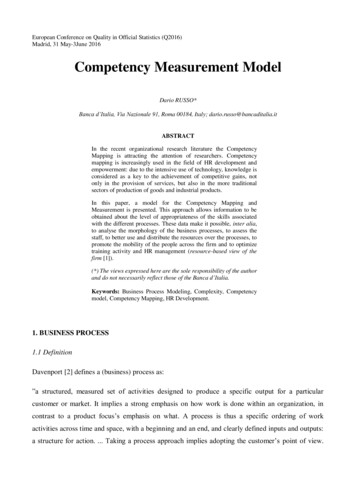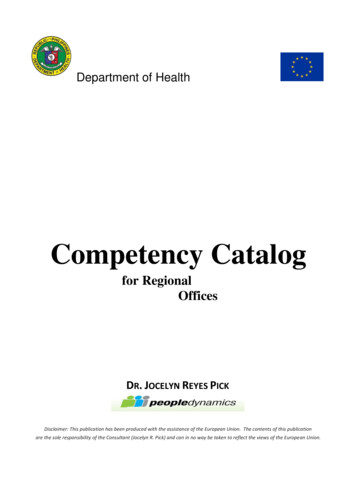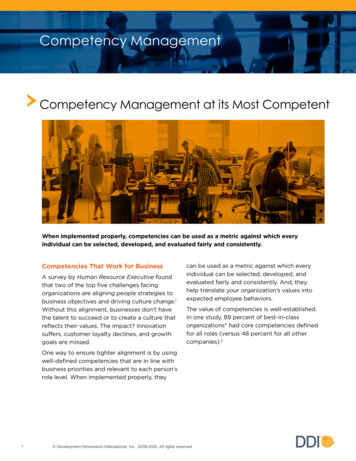
Transcription
Competency ManagementCompetency Management at its Most CompetentWhen implemented properly, competencies can be used as a metric against which everyindividual can be selected, developed, and evaluated fairly and consistently.Competencies That Work for BusinessA survey by Human Resource Executive foundthat two of the top five challenges facingorganizations are aligning people strategies tobusiness objectives and driving culture change.1Without this alignment, businesses don’t havethe talent to succeed or to create a culture thatreflects their values. The impact? Innovationsuffers, customer loyalty declines, and growthgoals are missed.can be used as a metric against which everyindividual can be selected, developed, andevaluated fairly and consistently. And, theyhelp translate your organization’s values intoexpected employee behaviors.The value of competencies is well-established.In one study, 89 percent of best-in-classorganizations* had core competencies definedfor all roles (versus 48 percent for all othercompanies).2One way to ensure tighter alignment is by usingwell-defined competencies that are in line withbusiness priorities and relevant to each person’srole level. When implemented properly, they1 Development Dimensions International, Inc., 2009-2020. All rights reserved.
Competency Management at its Most CompetentSuccess ProfilesSMDDI has created a holistic view of success(below), including—and expanding upon—competencies as traditionally defined.The Success Profile separates fourimportant and distinct components ofsuccess, resulting in a powerful frameworkfor selection decisions. This separationallows HR to give personal dispositions andmotivations—that are difficult to develop—extra attention when considering candidatesfor a role. The competency componentdefines the specific behaviors and capabilitiesthat need to be demonstrated proficientlyto achieve success. And, with the clearidentification of specific experiences andknowledge vital for success in a growthassignment, development can be individuallytargeted. Each component of the SuccessProfile describes unique requirements thatcan be fine-tuned to meet the needs ofyour various talent management systems.This is done by targeting only the mostcritical elements of the profile, which clearlydifferentiate exceptional performance frommediocre performance or worse.The Value of Success Profiles Varies byStakeholderThe design and launch processes should addvalue for four key stakeholder groups: seniorleaders, managers, employees, and the talentmanagement team. It is critical that youconsider each group and define what theywill gain from using the competency model.Senior Leaders. Success Profiles becomethe primary source of intelligence uponwhich crucial talent decisions can be made:the WHOs to put in available positions,or the WHATs required by your strategicdevelopment.They also ensure alignment of HR’s strategieswith those of the business. And, when thestrategy needs to change, Success Profilescan be quickly revisited to clarify what shouldremain constant and what should change tomeet new demands.Managers. Success Profiles focus managerson the critically important targets whenacquiring talent, developing and evaluatingemployees in current roles, and gettingemployees ready for future careers. Thisincreases managers’ confidence that theThe Success ProfileSM2 Development Dimensions International, Inc., 2009-2020. All rights reserved.
Competency Management at its Most Competentdecisions they make are fair and aligned withboth their team’s and the organization’s goals.For competencies to provide this value, theymust be defined at the appropriate job level.In addition, managers should be trained to usethe competencies and other elements of theSuccess Profile across all talent managementsystems.Failing to Realize the Competency PromiseEmployees. Success Profiles connectemployees at all levels to the organization’sstrategy by identifying how they can achieveexpected results at their job and level.Competencies provide clear expectations forhow goals should be accomplished, and theyhelp employees understand the skills theyneed to develop in their current and futureplanned roles. Employees should also beoriented to the meaning of the competenciesand trained in applying them. No strategic starting point; competencydevelopment is fragmented and haphazard.Talent Management Team. Success Profilesserve as the foundation upon which HRshould build and connect talent managementsystems. This unified approach reduces bothimplementation costs and confusion. Forexample, a Success Profile for a first-levelleader can be used for recruiting, onboarding,appraising performance, and development.During the competency modeling designprocess, HR should encourage stakeholderconversations about business challengesand then, and only then, choose connectedSuccess Profiles. The links to businesschallenges ensure buy-in by line managersand build the reputation of the talentmanagement team as effective businesspartners.3Even with the evidence pointing to the valueof competencies, many organizations stillfail to reap the full benefits. Organizationstypically face a variety of challenges whenimplementing competencies, including:Design Issues Little thought is given to how competenciesare going to be used across talentmanagement systems, or if used, they areapplied inconsistently.Launch Issues Descriptions of competencies are too broad.They are not a road map for taking actionvia specific behaviors. Users are not provided with the skills to usethe competencies effectively. The competencies are hard to embedconsistently into all talent managementsystems.Sustainability Issues There is no ongoing ownership oraccountability to support competencyapplications in systems. No process is in place to evaluate whatis working and not working or to makeappropriate changes. There is a lack of agility for a quick responseto changing business needs and no way toassess the value (ROI).As evidenced by these common challenges,even the best competencies are going tofall short if they aren’t executed properly.That’s not to say defining competencies isn’timportant; you must give equal considerationto both launching and deploying them. Development Dimensions International, Inc., 2009-2020. All rights reserved.
Competency Management at its Most CompetentThe Higher Power of Integrated TalentManagementIntegrated talent management is the processby which individual HR processes are alignedto common business objectives, as wellas to each other. DDI pioneered the entireconcept of integrated talent managementmore than 30 years ago, long before it wasan acknowledged best practice.3 Integratedtalent management systems enhance theimpact of all talent management systems.Bersin and Associates4 cites the followingorganizational benefits for integrated talentmanagement: 26 percent higher revenue per employee 40 percent lower turnover among highperformers 87 percent greater ability to “hire thebest people” 156 percent greater ability to “developgreat leaders”As shown below, DDI views Success Profilesat the center of what we call the TalentGrowth Engine. The key is aligning thesystems used to select and develop the talentaround your Success Profiles, which in turnshould be aimed at achieving your businessoutcomes and cultural strategy.Putting Competencies to WorkCompetencies have become widely popular,in part, because they provide value in diversework contexts, cultures, industries, and acrossmultiple talent management applications. Somecommon applications of competencies are:1. Talent Acquisition: As shown below, DDIresearch shows that companies that usecompetencies are more likely to rate theirstaffing processes as effective, when itcomes to filling key positions quicklyand effectively. Also, when organizationsthoroughly define holistic Success Profiles,they are better able to compete to sourceand hire the talent required. Finally, whenbusiness-critical competencies are targetedin interviews and assessments, the talententering the organization is better preparedto meet business needs, reducing ramp-uptime.Talent AcquisitionOur organization does a thorough job of determiningwhat knowledge, skills, abilities, and experiences futureemployees should have.Fueling Your Talent Growth Engine2. Learning and Development: Competenciesprovide the framework on which individualscan build development plans and managerscan provide feedback. At an organizationallevel, development can be more effectivelyplanned and implemented when specificbehaviors and skills are clearly identifiedand communicated. DDI’s research showsthat organizations that identify Success4 Development Dimensions International, Inc., 2009-2020. All rights reserved.
Competency Management at its Most CompetentProfiles are 4.8 times more likely to ratethemselves in the top 10 percent of theircompetitors based on the quality of theirleadership talent.3. Succession Management: Competenciesoffer clarity to senior leaders as theybuild talent pools to meet business needs.They provide standards against whichindividuals—across the organization—canbe assessed. With the intelligence thatcomes from assessment, organizations canpinpoint talent gaps before deficits reartheir ugly heads and negatively impactbusiness results. They can also better useSuccess Profiles to place those individualswho are best qualified for key promotionsor other opportunities.4. Performance Management: By leveragingcompetencies, managers and employeesgain a common language that spells outthe HOWs in performance plans. Withoutcompetencies, there is a tendency forperformance plans to rely too heavilyon the WHATs (outcomes/objectives),without providing behavioral guidance.Competencies help develop performanceplans so your associates understand thespecific behaviors they need to exhibitin achieving results. The competencyframework is useful in evaluating associates,and providing feedback throughout theperformance cycle.you can identify the behaviors or skillsessential to innovation. Managers needto reinforce the behaviors in line with thedesired culture and hire individuals into theorganization that possess skills and motivations that fit the culture.Achieving the Competency PromiseYour organization must take the time to putin place an overarching strategic plan for allphases of the design and implementationeffort as depicted in the grey-shaded, outercircle below. The four critical steps associatedwith effective competency management are:Plan for Impact, Design, Launch and Engage,and Optimize.Steps for Effective Competency Management5. Career Planning: By identifying andcommunicating the critical competenciesassociated with success at a job level,organizations can establish more strategiccareer-planning systems. Managers canhelp their employees identify career pathsfor future-focused development that willbetter prepare them for their next move.6. Culture: Competencies help make anorganization’s values tangible. For example,an organization may desire to build aculture of innovation. However, innovationas a value is somewhat nebulous unless5 Development Dimensions International, Inc., 2009-2020. All rights reserved.12341. Starting with a plan which sets a foundationfor success.2. Building Success Profiles that align withbusiness challenges.3. Engaging leaders and employees to usethe profiles.4. Assessing their impact and adjusting asneeded.
Order MattersMost organizations develop theirStep One: Plan for ImpactSuccess Profiles first, and then try Identify stakeholders’ needs and therequirements of various talent managementsystems.to line them up with their businessstrategies; the reverse shouldhappen. We suggest starting with theidentification of business imperativesand then using those imperatives todecide on appropriate Success Profiles.Below, you can see how thecompetency and personal attributecomponents of the Success Profilealign to a specific business priority.Talent AcquisitionAligning Success Profile componentsto strategy, via Business Drivers Determine launch strategies that engageemployees. Identify metrics and measurement methods toascertain what is working and what needs tobe improved.A McKinsey study found that organizationsthat planned from the outset for long-termsustainability were nearly twice as likely to begood competency implementers as those whodidn’t. Why is this important? Because the goodimplementers were also nearly five times morelikely to be successful at accomplishing theirchange efforts.Once a solid foundation with a strategic plan hasbeen set, follow the key activities below. Thesewill ensure success as you work through thesteps associated with successful implementation.Step Two: Design Tie the competencies to your business strategy. Identify those competencies that are criticalin all of your systems and those that are bestused in specific systems (e.g., less-trainablebehaviors such as adaptability in selectionsystems). Ensure competencies are relevant to each ofyour target levels (e.g., individual contributors,leaders, and executives). Well-designedcompetency models specify by job level thecompetencies and behaviors appropriate toeach level, and not just a single “one-size-fitsall” set of competencies.
Competency Management at its Most Competent To be scalable, focus on the behaviors ratherthan the tasks. Competency frameworksshould clearly define the common keybehaviors within each competency critical toeffectiveness, and avoid a lot of specificityabout tasks that can vary by job/role andchange frequently over time. To ensure scalable talent managementsystems, identify job families—thoseclusters of jobs that may have differentresponsibilities and titles, yet require similarcompetencies.Step Four: Optimize Establish ongoing accountabilities to helpdesign talent management systems thatsupport the model. Document and share successes, andidentify methods to evaluate the impact ofcompetency applications on business andtalent outcomes. Gain an understanding of any challenges inapplying competencies, and take action toaddress any issues. Focus on job transitions, areas wherecompetency requirements changesignificantly (e.g., individual contributors toleaders and managers to executives). Determine when the business strategyand the competitive situation requiremodifications to the competency model andquickly adapt the model to new challenges. Ensure your competencies are relevantto associates from all applicable cultures,functions, and locations. Establish ways to keep talent managementsystems in sync with changes in thecompetency model over time.Step Three: Launch and Engage Plan communications targeted to eachstakeholder group, establishing the valueof the competencies for each group. Integrate the competencies into your talentmanagement systems in ways that enhancetheir impact. Establish an engaging way to orient yourusers to—and reinforce buy-in for—thecompetency model. Train your employees and managersto use the competencies in your talentmanagement systems.Unfortunately, many organizations neglectone or more of these phases. Somecompanies have a few meetings to developa list of competencies. Other companies doextensive analysis and design, but spendlittle time launching the competencies sothat all employees understand and usethem. In other organizations, no one ownsthe competencies—no one helps with thedeployment and use of new competencies,evaluates their impact on the business, orrecognizes the need to adjust them as thebusiness evolves.But when done properly, you will be able toanswer key business strategy questions such as: Do we have the talent needed to win in themarketplace and sustain long-term growth? What leader competencies (at all levels) arecritical, but in short supply? What competencies and other attributesare not well-assessed or developed by ourcurrent talent management processes?7 Development Dimensions International, Inc., 2009-2020. All rights reserved.
Competency Management at its Most CompetentThe Bottom-Line Value: CompetenciesSupport Talent AnalyticsWith clear definitions of success, youcan measure your talent capabilities bycomparing business performance againstcompetency evaluation data.First, access assessment data from yourtalent management and performancesystems. This will provide information basedon the same elements identified during theDesign phase mentioned above. An analysisof these data will enable you to identify thecompetencies which differentiate would-beoutstanding performers from those who areineffective.Next, review your talent managementprogram’s evaluation results, such as users’perceptions of accuracy, relevance, andutility of your programs. These may alsoinclude outcomes such as rates of promotion,engagement results, and retention. Youshould also seek sales customer satisfaction,productivity, and quality and safety metrics.From these, you can effectively targetimprovements to all your talent managementsystems and minimize talent gaps that affectyour business and culture.When an integrated Success Profile isdeployed throughout your talent managementsystems, you’ll be able to perform talentanalytics to answer the critical questionswith a higher degree of speed and accuracy.This is the promise of optimized competencymanagement.Just Too Many Competencies?Too often competency models use onlygeneralized descriptors of meanings orprovide a one-size-fits-all definition for aconcept. For example, Coaching Others:If the competency is too vaguely defined, amanager may fail at fully developing all thebehaviors associated with proper coaching.Well-written competencies include keyactions that specify the component behaviorsthat lead to strength and define the uniquebehaviors that lead to success, across keyleadership levels throughout the organization.These behaviors provide a better guide forevaluation and development.A better competency library would includewell-defined behavioral anchors thatdifferentiate HOW to coach others forexecutives versus coaching for front-to-midlevel leaders. The coaching example belowoffers a more explicit example of coachingbehaviors defined for multiple levels ofleadership:Example: Coaching and Developing Others(for Executives) Providing feedback,instruction, and development guidance tohelp others excel in their current or future jobresponsibilities; planning and supporting thedevelopment of individual skills and abilities.Key Actions: Clarifies performance Provides timely feedback Conveys performance expectations andimplications Evaluates misalignment Facilitates development Fosters developmental relationships8 Development Dimensions International, Inc., 2009-2020. All rights reserved.
Competency Management at its Most CompetentExample: Coaching (for Front to Mid-LevelLeaders) Engaging an individual in developingand committing to an action plan that targetsspecific behaviors, skills, or knowledgeneeded to ensure performance improvementor prepare for success in new responsibilities.Key Actions: Aligns expectations for the discussion Defines the performance challenge Maintains motivation Engages and involves Offers support Gains agreement Establishes action planTo learn more about Success Profiles, filesEndnotes*Best-in-class organizations were defined as thosethat had 84 percent of employees receiving a rating of“exceed” on their last performance review; 81 percent ofkey positions had at least one willing and able successoridentified; and there was a 33 percent average, yearover-year improvement in hiring manager satisfaction(Aberdeen, 2010).1 Human Resource Executive’s 2014 “What’s Keeping HRUp at Night” survey.2 Lombardi, M., & Saba, J. (2010). Talent AssessmentStrategies: A Decision Guide for OrganizationalPerformance. Aberdeen Group.3 Byham, W.C. (1981). Applying a systems approach topersonnel activities, DDI.4 Sherman Garr, S., (2012) Integrated Talent Management:A Roadmap for Success. Bersin and Associates.9 Development Dimensions International, Inc., 2009-2020. All rights reserved.
About DDIDDI is a global leadership consulting firm that helps organizations hire,promote and develop exceptional leaders. From first-time managersto C-suite executives, DDI is by leaders’ sides, supporting them inevery critical moment of leadership. Built on five decades of researchand experience in the science of leadership, DDI’s evidence-basedassessment and development solutions enable millions of leadersaround the world to succeed, propelling their organizations to newheights. For more information, visit ddiworld.com.EMAIL: info@ddiworld.comVISIT: www.ddiworld.com Development Dimensions International, Inc., 2009-2020. All rights reserved.
allows HR to give personal dispositions and motivations—that are difficult to develop— extra attention when considering candidates for a role. The competency component defines the specific behaviors and capabilities that need to be demonstrated proficiently to achieve success. And,
